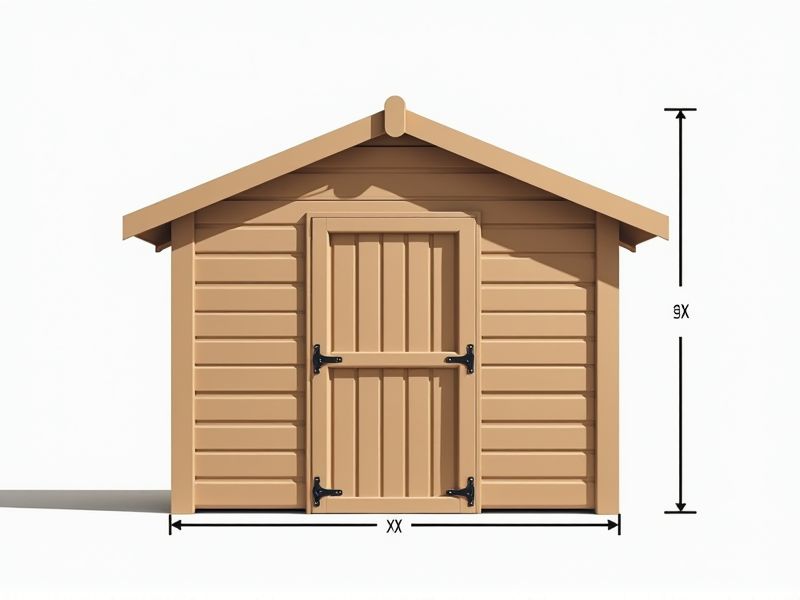
When planning for a shed, it's helpful to know the standard dimensions commonly found in the market. The most popular shed sizes are 6x8 feet, 8x10 feet, and 10x12 feet, offering enough space for garden tools, bikes, or small equipment. For larger storage needs, you might consider a 12x16 or even a 12x24 foot shed, which can also serve as workshops or hobby spaces. By measuring your available yard space and considering your storage requirements, you can choose a shed size that best fits your needs and maximizes functionality.
Width
The standard width for a garden shed typically ranges from 6 to 12 feet, accommodating various storage needs. Choosing a width that aligns with your available space can enhance functionality; for example, a 10-foot wide shed often provides ample room for gardening tools and outdoor equipment. If you plan to store larger items, consider widths exceeding 12 feet, which can offer more versatility. Your choice should also factor in local building codes and property lines, ensuring compliance and maximizing usability.
Length
The standard length for a garden shed typically ranges from 6 to 12 feet, depending on your storage needs. For larger items like bicycles or lawnmowers, sheds with lengths of 8 to 10 feet are ideal. You should consider the available space in your yard when selecting a shed, as most local regulations dictate a minimum distance from property lines. A well-planned 10-foot-long shed can provide ample space for tools, gardening supplies, and outdoor equipment, making it a practical choice for maximizing efficiency in your backyard.
Height
A standard shed typically has a height of around 8 feet at the peak, allowing ample vertical space for storage and movement. This height accommodates various shelving options and equipment, making it a practical choice for organization. For taller structures, consider sheds with an eave height of 6 to 7 feet, providing adequate clearance for larger items. Ensuring proper height in your shed can enhance functionality, making it easier to utilize every inch efficiently.
Roof Pitch
Roof pitch, defined as the steepness of a roof, is typically measured as a ratio of vertical rise to horizontal run, commonly expressed in inches per foot. A standard pitch for a garden shed often ranges between 4:12 and 8:12, balancing aesthetic appeal and functionality while promoting efficient water drainage. Choosing the right pitch can also impact insulation and overall structure stability, with steeper roofs generally providing better snow shedding capabilities. For optimal performance, consider local climate conditions when determining your shed's roof pitch.
Eave Height
Eave height refers to the vertical distance from the ground to the lowest point of the roof overhang, significantly impacting the usability and aesthetics of your shed. Standard eave heights typically range from 6 to 10 feet, accommodating both storage and workspace requirements. Choosing an appropriate eave height can enhance ventilation and create a more comfortable environment for various activities. When planning your shed, consider local building codes, as some areas may have specific regulations regarding maximum or minimum eave heights.
Door Size
The standard door size for a shed typically measures 36 inches in width and 80 inches in height, providing ample space for easy access. However, some homeowners prefer larger doors, opting for 48 inches wide to accommodate wider equipment and tools. When designing your shed, consider how the door's location affects functionality; placing it for direct access to frequently used items enhances convenience. Additionally, you may choose to install a double door system, which can create a grand entrance and increase accessibility for large items.
Window Size
When considering the standard window size for a shed, optimal dimensions typically range from 36 by 48 inches to enhance both natural light and ventilation. A standard shed often includes one or two windows to provide airflow, which can significantly reduce humidity and improve air quality inside. Properly placed windows can also stave off issues related to mold, keeping your tools and equipment in better condition. You should choose windows made from durable materials to withstand weather exposure and promote the longevity of your shed.
Foundation Dimensions
A standard shed foundation typically measures 4 inches thick and consists of materials such as concrete, wood, or gravel, depending on the shed's size and purpose. For a 10x12 foot shed, the foundation should cover a minimum area of 120 square feet, providing a stable and level base. Ensuring proper drainage around the foundation is crucial; aim for a slope of at least 1 inch per foot away from the shed. Using pressure-treated wood or concrete blocks can enhance durability and resistance to moisture, extending the life of your shed.
Overhang
The standard shed design typically features an overhang that extends 12 inches beyond the walls, providing important protection against rain and sun exposure. This overhang not only enhances the aesthetic appeal but also contributes to the longevity of the structure by reducing water runoff against the siding. For proper ventilation, the top edge of the overhang often allows air circulation, which is crucial in preventing mold buildup and wood rot. With a well-designed overhang, you can effectively improve the functionality and sustainability of your shed while maintaining its structural integrity.
Internal Spacing
The internal spacing of a shed plays a crucial role in optimizing usability and functionality, often requiring a minimum of 24 inches between shelves for ease of access. Effective internal organization can enhance storage capacity by up to 30%, allowing you to maximize every square foot of available space. Incorporating adjustable shelving can further accommodate various items, providing flexibility as your storage needs evolve. For your design, consider at least 60 inches of height for vertical clearance, facilitating movement and enhancing overall efficiency.
